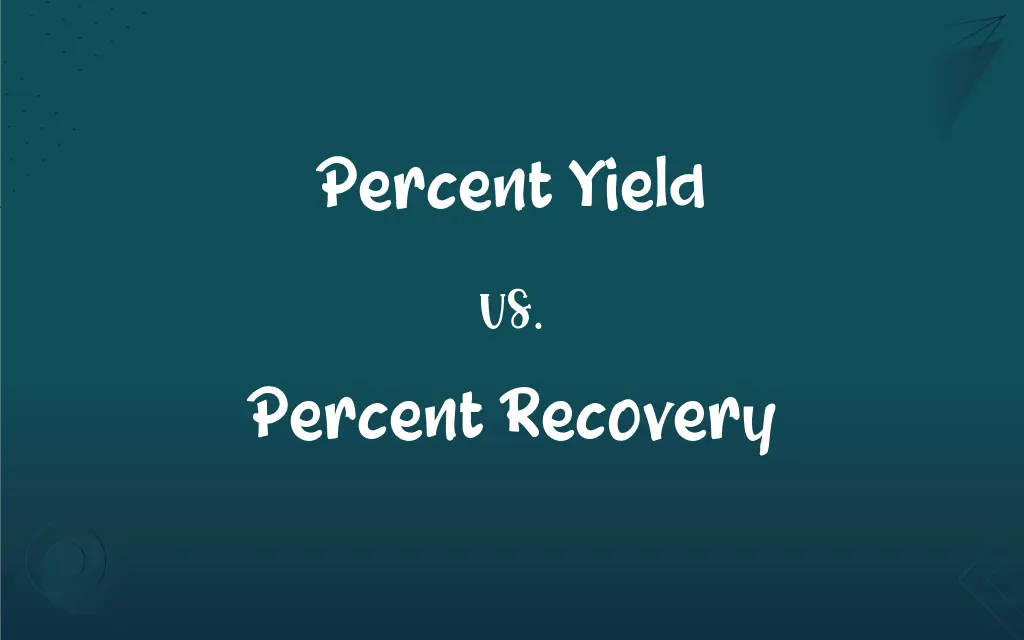Percent Yield vs. Percent Recovery: What's the Difference?
Edited by Janet White || By Harlon Moss || Published on December 7, 2023
Percent yield is the ratio of the actual yield to the theoretical yield in a chemical reaction, while percent recovery refers to the amount of material recovered compared to the original amount before processing or purification.

Key Differences
Percent yield in chemistry is a measure of the efficiency of a reaction, calculated by comparing the actual yield of a product to its theoretical yield. Percent recovery, on the other hand, is used to assess the effectiveness of a purification or extraction process by comparing the quantity of material recovered to the original amount.
The theoretical yield, against which percent yield is measured, is derived from stoichiometric calculations based on the limiting reactant. Percent recovery, however, involves measuring the amount of a specific substance recovered after a process like extraction, distillation, or purification.
Percent yield is crucial in evaluating the practical success of a chemical synthesis, indicating how close the experiment comes to the expected theoretical outcome. Percent recovery is important in processes where material is purified or isolated, indicating the extent to which the original material is successfully retrieved.
In laboratory settings, achieving a high percent yield is desirable for the efficiency of chemical reactions, whereas a high percent recovery is essential in processes where retaining the integrity of the original material is crucial, such as in pharmaceuticals.
Percent yield can be affected by factors such as reaction conditions and the purity of reactants. Percent recovery is influenced by the efficiency of the purification process and the physical properties of the material.
ADVERTISEMENT
Comparison Chart
Definition
Ratio of actual yield to theoretical yield
Ratio of material recovered to original amount
Measurement Against
Theoretical yield from stoichiometric calculations
Original amount of material before processing
Relevance
Efficiency of a chemical reaction
Effectiveness of purification/extraction
Desired Outcome
High yield, indicating efficient reaction
High recovery, indicating minimal loss
Influencing Factors
Reaction conditions, purity of reactants
Efficiency of process, material properties
ADVERTISEMENT
Percent Yield and Percent Recovery Definitions
Percent Yield
Percent yield is the actual yield of a product as a percentage of its theoretical yield.
The percent yield of the reaction was 75%, indicating good efficiency.
Percent Recovery
Important in assessing the loss or retention of material in chemical processes.
Our goal was to maximize percent recovery to reduce waste.
Percent Yield
A measure of how much product is obtained compared to what was expected theoretically.
We calculated a percent yield of 80% for the synthesized compound.
Percent Recovery
Percent recovery is the amount of substance recovered after processing, compared to the initial amount.
The percent recovery of the purified substance was 90%.
Percent Yield
Reflects the efficiency of a chemical reaction in producing the desired product.
A high percent yield means the reaction was almost as productive as theoretically possible.
Percent Recovery
Percent recovery can vary depending on the techniques and conditions used.
We improved the percent recovery by optimizing the extraction parameters.
Percent Yield
Used to evaluate the success of a laboratory synthesis.
The experiment’s percent yield was lower than expected, suggesting some loss of product.
Percent Recovery
Reflects the efficiency of a purification or extraction process.
A high percent recovery indicates that the extraction method was effective.
Percent Yield
Percent yield can indicate the practical limitations of a chemical reaction.
The percent yield was affected by impurities in the reactants.
Percent Recovery
Used to determine the success of recovering a substance from a mixture.
The percent recovery in the distillation process was surprisingly high.
FAQs
What is percent yield?
Percent yield is a measure of the efficiency of a chemical reaction, expressed as the percentage of the actual yield to the theoretical yield.
Why is percent yield important?
It helps in assessing the efficiency and practicality of a chemical synthesis.
How do you calculate percent yield?
Percent yield is calculated as (Actual Yield / Theoretical Yield) × 100%.
Can percent yield be used to determine reaction mechanism?
Not directly, but it can provide insights into the efficiency of different pathways.
Can percent yield be more than 100%?
Yes, though rare, it can exceed 100% due to impurities or measurement errors.
Is percent yield the same as efficiency?
Essentially, yes, as it measures how efficiently reactants are converted to products.
What factors affect percent yield?
Factors include reaction conditions, purity of reactants, and measurement precision.
How does temperature affect percent yield?
Temperature can influence the rate and equilibrium of reactions, thus affecting yield.
How can percent recovery be improved?
By optimizing the recovery process, reducing losses, and improving the purity of substances.
Why is percent recovery important?
It assesses the effectiveness of purification or extraction processes.
Is 100% recovery possible?
It's theoretically possible but practically very difficult due to inevitable losses.
How do you calculate percent recovery?
Calculate it as (Amount of Substance Recovered / Original Amount of Substance) × 100%.
What does a low percent recovery indicate?
It suggests loss of material or inefficiencies in the recovery process.
Is a higher percent yield always better?
Generally, yes, as it indicates a more efficient reaction, but it must also consider purity and practicality.
What does a low percent yield indicate?
It suggests inefficiencies in the reaction or experimental errors.
What is percent recovery?
Percent recovery refers to the amount of a substance recovered from a process compared to the original amount before processing.
What factors affect percent recovery?
Factors include the method of recovery, purity of the substance, and procedural losses.
How does percent recovery differ from percent yield?
Percent recovery focuses on the recovery of a substance after processing, while percent yield relates to the efficiency of a chemical reaction.
Is percent recovery relevant in all types of chemical processes?
It is particularly relevant in processes involving purification, extraction, or recycling of materials.
Can percent recovery be used to judge purity?
Indirectly, as higher recovery rates can suggest fewer impurities being introduced.
About Author
Written by
Harlon MossHarlon is a seasoned quality moderator and accomplished content writer for Difference Wiki. An alumnus of the prestigious University of California, he earned his degree in Computer Science. Leveraging his academic background, Harlon brings a meticulous and informed perspective to his work, ensuring content accuracy and excellence.
Edited by
Janet WhiteJanet White has been an esteemed writer and blogger for Difference Wiki. Holding a Master's degree in Science and Medical Journalism from the prestigious Boston University, she has consistently demonstrated her expertise and passion for her field. When she's not immersed in her work, Janet relishes her time exercising, delving into a good book, and cherishing moments with friends and family.






































































